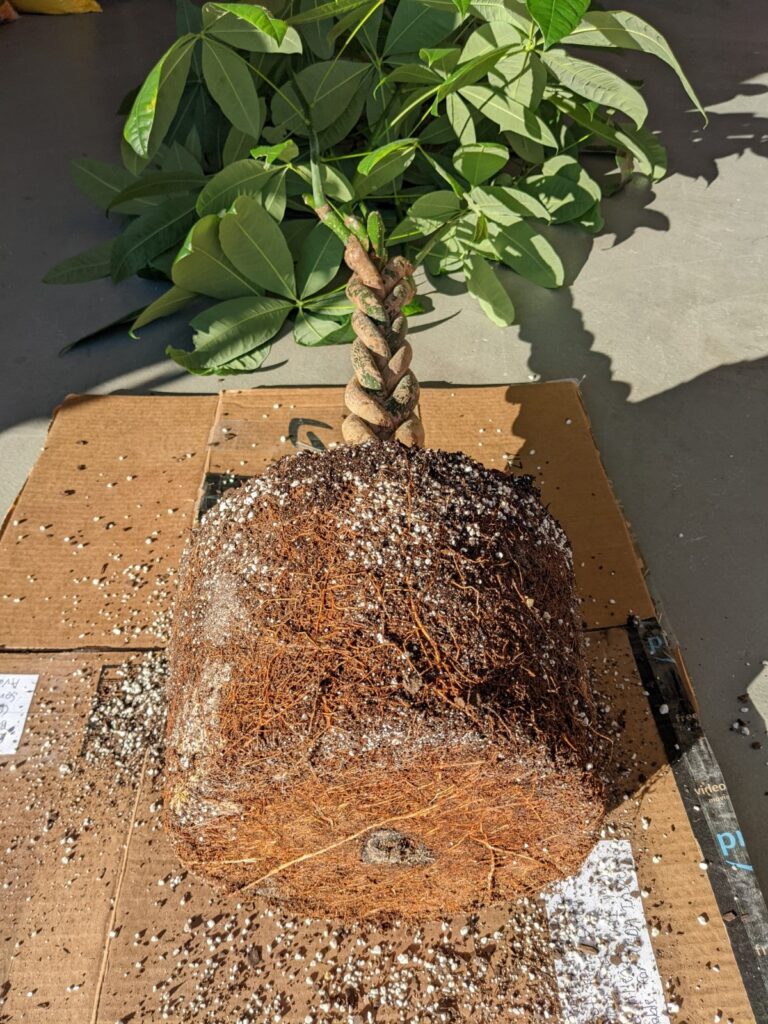I repotted my Money Tree fairly recently. One thing that struck me was how fine and delicate the roots were. So I thought it would be nice to create a post on Money Tree roots for all the plant lovers like me. On plant forums, you often see people ask questions about the leaves or even the stems of their houseplants. That’s the part we actually see all the time. However, what’s under the soil is often what is most important for a plant’s overall health.
Money Trees in the Wild
Money Trees, or Pachira Aquatica are native to south and central America. Like many wild plants turned houseplants, they are native to tropical locales. In the wild, they typically grow in swamps where they will flower and grow chestnuts. Growing in swamps gives us some tips on what type of soil the roots may prefer, which I’ll discuss later. Also, don’t expect your indoor Money Tree to flower or fruit though. However, they can grow quite large indoors if cared for correctly. Check out my Money Tree pruning post to see how large mine becomes every few years before I trim it back.
Money Tree Roots

Healthy Root Appearance
Generally speaking, Money Tree roots should be whiteish or light brown. The roots are pretty thin and fine compared to some other houseplants, especially vining-type houseplants. Healthy roots should be firm to the touch. In addition, there should not be any odor coming from the roots or the soil. The majority of Money Trees that I have seen sold as houseplants come braided with several trees to one pot, so keep in mind when examining the roots that you’re dealing with multiple plants. That said the roots are so fine and intertwined that dealing with each plant separately would be difficult anyway.
If the soil is very moist and the roots are squishy or they smell, then you may be dealing with root rot. Root rot is caused by an abundance of moisture in the soil. Too much moisture leads to disease and rotting in the roots. That can be tricky to manage especially for swamp native plants like the Money Tree. They like moist soil, but it can’t be too moist. A good way to preempt overwatering your plant is to pay close attention to soil moisture. A moisture meter makes quick work of this task. I always use one before I water to make sure that my plants actually need to be watered.
It’s tempting to want to stick to a watering schedule but things change all the time and it can be eye-opening how unpredictable soil moisture can be. If it rained a lot in your area, your plant may not dry out as quickly. Once it gets cold and the heater is on the soil can dry out more quickly if it’s near a vent, or it may dry less quickly because it’s dormant in the winter. There are a lot of factors that can go unnoticed, so I like to rely on a moisture meter.
Mannerisms
Money Tree roots are relatively slow growing compared to some houseplants. Their root systems are pretty shallow for a tree of its size. Because of this, they can go many years between repotting. In fact, I’d say I repot my Money tree every three-ish years and I have a pretty large tree that grows fast. If you’re interested, check out my post on repotting a Money Tree.
How to Keep Roots Healthy
Money Trees are quite resilient houseplants. They often make the list of the easiest houseplants to care for. I recommend them specifically to people who are chronic over-waterers. That said, it’s best not to test the limits of their resilience. A well-draining soil is pretty much always recommended for houseplants and Money Trees are the same.
Money Tree roots do like to stay evenly moist though, being from the swamp and all. Like many plants, you can find pre-mixed soil that is made especially for Money Trees. You can also just mix your own and you don’t need anything super fancy. I use regular potting soil and then add a little extra perlite to boost up the drainage. I typically use a ratio of 3:1 potting soil to perlite.
In addition to well-draining soil, healthy roots need the occasional nutrient supplement. Indoor Money Trees are not heavy feeders. I recommend fertilizing about once a month during the growing season and not at all when it’s dormant. You don’t need any specific type of fertilizer just find an all-purpose houseplant fertilizer. And note that water-soluble fertilizers feed the plant more readily than slow-release fertilizer spikes, so it is easier to keep track of what you’re doing with water-soluble.
I hope I have answered all your questions about Money Tree roots. If not, post your question in the Comments section.

I'm a long time plant lover on the quest to happily coexist with as many plants as I can. Let's grow!
